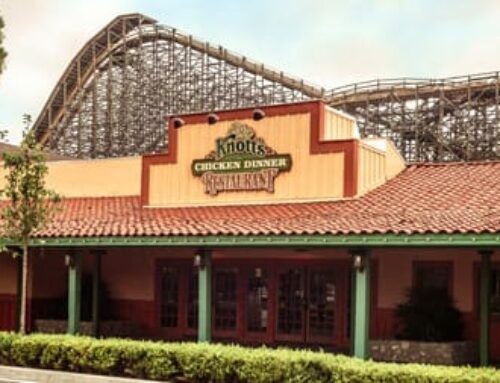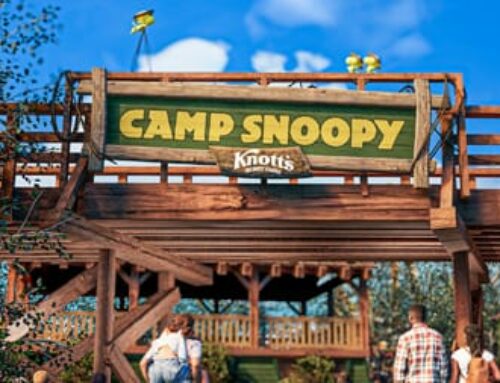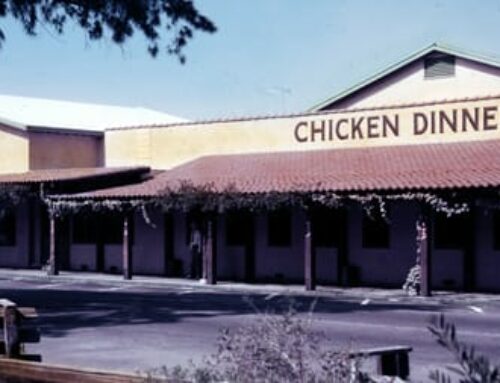It’s high noon, and a threat looms over the good people of Knott’s Berry Farm. The robot menace is here and the only thing keeping the park from complete destruction is my catlike reflexes and the keen eye of my stalwart companion, Jeff Heimbuch. Well, they had a good run. Boysenberry Festival may be canceled*, but I for one welcome our new robot overlords. This is the world of VR Showdown in Ghost Town, the newest, cooperative multiplayer virtual reality attraction at Knott’s Berry Farm, tucked away inside the arcade.
The press preview we attended was not complete, with the opening crash course/exposition dump video not being included, but the props and information we were able to gather suggests that the cause of all the trouble involves time travel and builds upon the existing lore of Professor Welles’ Time Machine from Kingdom of the Dinosaurs (which was replaced by the nearby Voyage to the Iron Ref in 2015). It’s good to see Knott’s building upon its lore, and I’m sure park veterans will spend hours poring over the little details they incorporated to set the stage for the virtual experience. The décor has a comfy retrofuture feel to it with an array of polished brass doohickeys and whatsits dating somewhere between the Renaissance and WW2 give or take a couple of years displayed against a suit of Fallout power armor (including an attention-grabbing animatronic hand) and a computer panel that looks like it was ripped out of Forbidden Planet. It’s goofy and kitschy, but how the whole thing comes together is going to depend on how much the introduction video sucks the guest into the story.
When the experience begins, you’re brought through a hallway featuring a bunch of pods that feels like a prison ship or a place where you might quarantine a deadly, intergalactic plague. It looks nice, but the dramatic shift in aesthetic is a bit jarring. The actual play space is blander still, featuring only a rug and curtain with some swirly patterns on it. The detriment to the experience created by this area, and similarly by the hallway that proceeds it, is mitigated by the fact that you’ll likely spend all of a minute or two in these areas before getting to the meat of the experience, but given that the main attraction is 3 minutes long, that’s a good portion of the experience that could be improved with the addition of a more thematically-appropriate curtain.
But you didn’t come here for curtain talk, no, you want to know how the actual VR part is. Well, the good news is that’s where the money went. Using enterprise-level technology powered by VRstudios VRcade, Knott’s has pioneered the first permanent installations of a free-roaming multiplayer VR experience in the US, and as a VR enthusiast, it was a real thrill to be able to try it out. 
To begin the experience, a staff member in a lab coat (who could maybe be given character/script? Just throwing out ideas, it’s the little things) secures the VR headset and headphones and then offers what will for many be their first taste of proper VR with tracked motion controllers as you’re asked to grab your gun, which is perfectly tracked in space and modeled to match its real-life counterpart. One important omission makes this experience stand out from 99% of the VR experiences today, however—there are no wires. For the uninitiated, this may seem a small thing. “I am a man,” you say, “I will not be thwarted by mere wires!” In practice, however, is both tremendously psychologically freeing, it also makes possible the other major accomplishment Knott’s has achieved with VR Showdown in Ghost Town, the ability to track multiple people over a 20’ x 17’ space. I’ll get a bit more into the technical details at the end for those that care, what’s important is that even if you could somehow devote that sort of space to VR, keeping it free of the debris that can spell disaster when immersed in VR, no consumer VR technology can track an area that large, or track multiple in the same area. Even for those willing to invest the significant cost involved in owning a VR headset, this is something that is simply not possible with what is available to consumers.
After a short explanation that boiled down to “shoot robots, collect power-ups,” we were left to our fate. Would Jeff and I rise up to become the heroes that Knott’s deserves and prevail over the robot menace, and if not, who is to blame for our destruction? (Spoilers: Nope and mostly me)
Two things that instantly stuck out upon starting up the experience were the fact that Jeff was there represented as a sort of Portal meets Wall-E head-and-torso robot and it really felt like I was in an idealized vision of Knott’s Berry Farm’s Ghost Town. Familiar locales come to life without virtual townsfolk having to worry about being the poor sod whose saloon is built beneath the rollercoaster. The gameplay is simple but satisfying, an experience only about 3 minutes deep, but made captivating by the fact that it doesn’t overstay its welcome and the sheer thrill of being able to move freely in this iconic, reinvigorated world. Mechanically it’s a horde shooter, a safe choice, but a sensible one, given the multiplayer component and the fact that they have to accommodate players of all skill levels, the core mechanics being understandable even without the abbreviated introduction we had. I will admit certain subtleties were missed, as I would pick up an item and continue to fire my gun without any noticeable differences, forgetting that I probably picked up autofire and don’t need to continue firing manually. More of a visual notification here would be helpful, especially if there are multiple powerups, but I’m not sure on that one. The difficulty is both trivial and fairly high, trivial in that there is no fail state until the end, the bots can bash on you till the cows come home and you’ll only be out a few points, but bash they will, with our poor excuse for an encampment constantly being besieged by multiple threats. The team suggested that the difficulty may have been switched to four player mode, increasing the spawn rate to unreasonable levels, but I think they were just trying to make me feel better so I don’t give them a negative review out of humiliation.
VR Showdown in Ghost Town can be scaled for anywhere between 1 and 4 players, in fact, with up to 16 players being able to be accommodated in 8 pods at any given time. Knott’s has wisely chosen to not have all 4 players occupying the same play space, which would almost certainly result in frequent collisions, instead having 2 players per pod, with 3 and 4 player teams viewing the action from different perspectives. This variety is enhanced by a few gameplay mechanics involving shooting key pieces of scenery at the right time to avoid catastrophe and collect sweet, sweet points.
These are tallied and ultimately determine who is capable enough to be saved in case of a robot apocalypse. While the action is a bit one-note, there are a few distinct phases to keep you on your toes. The first is the standard shooting gallery with 3 mini-bosses that need to be thwarted before they wreck the park. The second is an impressive sequence that required us to contort and move around the space as the hijacked Steam Engine 41 explodes in slow motion and we had to dodge or shoot the debris. The final phase is a boss battle against what the film Wild, Wild West has convinced me was a common threat at the time, a giant mechanical spider. Shoot its weak points for massive damage and it withers and dies. At least, I imagine it does. Ours got away. I wanted to say we both gave it our all, but were simply outmatched. However, the points told a different story. Jeff had 60,000 points. Me? 25,000. I had doomed the park, doomed those bountiful fields of boysenberries**, but I have to say, I had a great time doing it.
VR Showdown in Ghost Town is a simple, colorful VR experience that most people are going to have no problem getting acclimated to, while still managing to be an incredibly engaging experience for gamers and those that may have some VR experience. It’s $6 per person and offers a glimpse at an experience that isn’t even possible with top of the line consumer hardware costing upward of $600 assuming you already own the required gaming PC. In making further strides with VR, Knott’s has created an experience that could potentially outlive many traditional rides, developing technology allowing them to update both the experience itself and the way we interact with it. The time travel concept can be used for just about any experience allowing for the experience to be continually modernized and never become obsolete without costly physical renovations. It’s the start of something great, and even in its current state offers a one-of-a-kind experience that might not be worth making a special trip out to the park for, but should absolutely not be missed on your next visit out. The attraction opens on April 1st.
For those interested in the technology powering this experience, I didn’t get the specs on the PCs, but I didn’t notice any frame drops, everything ran at a smooth 60 FPS. Yes, 60 FPS. While the VRStudios rep said that there is some minor interpolation going on (translation: software magic that makes it look like an animation has more frames than it actually does) the content is being rendered at 60 FPS. This didn’t bother me, but those particularly sensitive to FPS changes above 60 will want to note that this is the same as other mobile VR solutions such as Samsung’s Gear VR.
We were also told the resolution was not quite 1080p, whereas top consumer models are a bit above 1080p, but the VRstudios rep explained that the difference wasn’t as significant given the higher quality screens used. If there was any screen door effect (being able to see the border between pixels when screens are very close to your eyes) I didn’t notice it, but the resolution did seem a bit lower than other high end VR headsets, likely a sacrifice to maintain a solid 60 FPS while communicating wirelessly. It’s not a huge deal given how bright and visible everything is, but it does make far away targets a bit harder to hit. Of course, that could just come down to a more fundamental and difficult problem to fix: IPD adjustment. IPD or interpupillary distance, is, as it sounds the distance between your pupils. For men, this is on average around 64mm and 64mm for women. Mine are around 62mm. What does this mean? Well, it means that I’m a hideous abomination that should be hidden away as to not spook the peasantry, but it also means that screens set to the average don’t converge perfectly for me, and they won’t for you either, depending upon how far you deviate from that average. It wasn’t a huge deal in terms of enjoying the visuals, but it did make aiming a significant challenge at times, especially given the lack of a reticle. This is almost certainly why I lost to Jeff, whose eyes are clearly ideally spaced for maximum accuracy in VR. Some people have all the luck. Unfortunately without some sort of automaticeye-tracking IPD adjuster or a manual adjustment for each guest, I’m not sure how you tackle this issue.
Everything else technology-wise is proprietary, with a tracking system that managed to track both of us well enough as we moved around each other to both not get us mixed up and ensure we knew where the other was at all times.
*The editors of Horrorbuzz.com have asked me to note that the 2017 Boysenberry Festival, running from April 1 – April 23 has not been canceled and tickets are available now. We apologize for any panic caused by this bad comedy.
**The editors of Horrorbuzz.com have asked me to note that the boysenberries are fine, see footnote 1.















